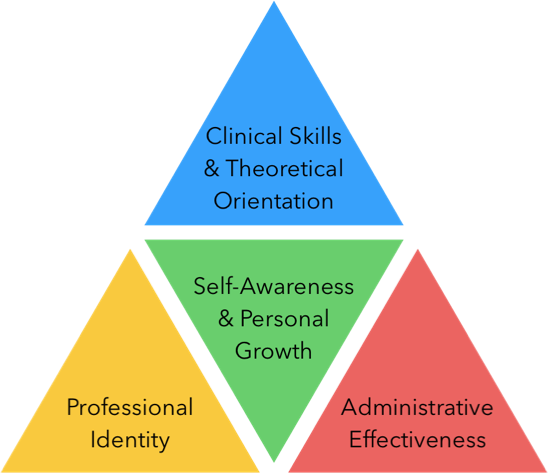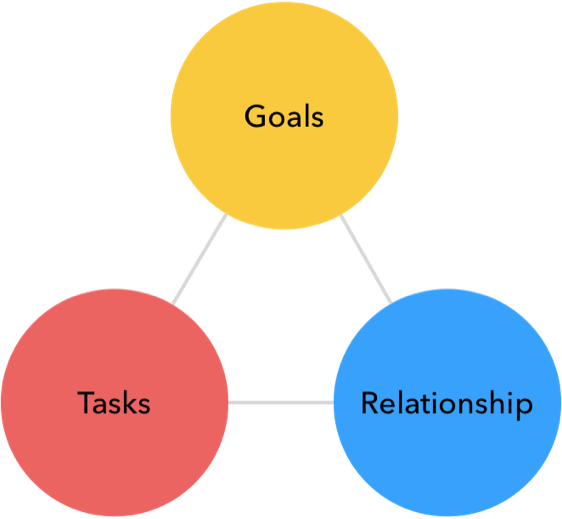IJust as there are many different models of psychotherapy, there are many different models for supervision. Ultimately, as therapists, most of us end up finding a mix of approaches that work for us, and integrating those models together to create our own ‘special sauce.’ I wanted to share about two such models that help me understand supervision: the clinical training triangle and a transtheoretical model of the working alliance.
The Clinical Training Triangle
This model is adapted from Noeticus Counseling Center and Training Institute, where I did my master’s internship (Kennedy, 2012). It outlines four key areas of learning for new professionals in the counseling field: clinical skills and theoretical orientation, professional identity, administrative effectiveness, and self-awareness and personal development.

Here are some examples of elements associated with each domain:
Clinical Skills and Theoretical Orientation: case conceptualization, technical interventions, building the therapeutic relationship, repairing alliance ruptures, diagnosis and assessment
Professional Identity: developing a professional niche, implementing professional attire and manners, maintaining an orderly and inviting office space, developing a consistent brand identity, professional conduct within the counseling community
Administrative Effectiveness: creating timely and accurate clinical notes, scheduling, HIPPAA-compliance, maximizing effectiveness of administrative duties, maintaining accurate and complete records for licensure, billing, work-life balance
Self-Awareness and Personal Development: learning and growing as the person who is the therapist, overcoming personal obstacles to full participation in the therapeutic encounter, finding existential fulfillment in one’s vocation as a psychotherapist
A well-rounded pre-licensed supervised work experience should help licensed professional counselor associates and licensed marriage and family therapy associates develop in all four of these domains. My approach to supervision includes working with all four, as they are all essential to the professional practice of psychotherapy.
The Working Alliance: Goals, Tasks, and Relationship
This transtheoretical model of the working alliance was first articulated by Edward Bordin in a 1975 paper (cited in Horvath, Del Re, Flückiger, and Symonds, 2011). In this model, the working alliance is a collaborative process that entails goals that the therapist and client agree upon, specific tasks (therapeutic interventions, activities, homework, etc.) that both parties believe will be helpful, and a beneficial relationship that both parties are active in shaping and negotiating. One of the strengths of this model is that it can accommodate a wide variety of theoretical orientations and interventions, while focusing on the collaborative, relational character of good therapy.

(adapted from Bordin, 1975)
I use this model both as a teaching model for helping supervisees develop and conceptualize their practice of psychotherapy, and as a model for understanding and negotiating the supervisory relationship. Thus, supervision with me entails us identifying your goals for supervision, establishing and working on tasks to meet those goals, and building and navigating a beneficial relationship that will help you feel supported in your work and challenged to grow.
Common Goals and Tasks of Clinical Supervision
Guided by these transtheoretical models, I believe supervision often involves goals and tasks like these:
- clinical decision-making
- screening potential clients
- private practice business skills
- setting fees
- navigating multiple relationships
- building a professional network
- honing your marketing to find clients you love to work with
- developing your clinical specialties and professional niche
- ethical practice
- timely recordkeeping
- understanding and abiding by laws and rules
- telehealth competency
- in-person counseling competency
- fulfilling requirements for supervised hours
- HIPPAA requirements and client privacy
- professional training and personal growth
If my approach appeals to you and you’d like to talk more about the possibility of working together, please get in touch! I’d be glad to make a time to talk about how I can help you reach your goals for supervision.
References
Bordin, E. S. (1975, September). The working alliance: Basis for a general theory of psychotherapy. Paper presented at the Society for Psychotherapy Research, Washington, DC.
Horvath, A. O., Del Re, A. C., Flückiger, C., & Symonds, D. (2011). Alliance in individual psychotherapy. In J. C.Norcross (Ed.), Psychotherapy relationships that work: Evidence-based responsiveness (2nd ed, pp. 26–69). Oxford University Press.
Kennedy, J. R. (2012). Clinical training manual [Unpublished manuscript]. Noeticus Counseling Center and Training Institute.
